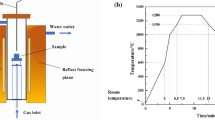Abstract
Burnt lime and serpentine were incorporated into the sinter mix to improve high iron and low silica sintering. Optimization of how to use burnt lime including dosage of burnt lime, moisture of sinter mix, hydrating and granulation time was performed. Evaluations of sinter characteristics including sinter mineralogy, reducibility, low temperature reduction degradation, softening and melting down properties were carried out. Compared with the results of traditional process in base case, the tumbling index (TI) is increased by 1.53%–2.33% through proportioning high ratio of burnt lime or adding serpentine in the sinter mix. It is shown that effective granulation, better permeability and improved high temperature reactivity in the sinter bed are achieved, resulting in an increase in 3.13%–5.10% calcium ferrite occurring in acicular and columnar shape and decrease in glass phase, and with the reducibility index(RI) being increased by 1.65%–3.25%.
Similar content being viewed by others
References
Astier J E. Main development in iron ore preparation [A]. The Second International Conference on the Iron Ore Industry[C]. Kiruna, Sweden: Lulea University, 2002.
Inazumi T. Recent trends in sintering technology for the improvement of process efficiency[A]. Proceedings of the 6th International Symposium on Agglomeration[C]. Tokyo, Japan: Iron and Steel Institute of Japan, 1993. 4–10.
Sassa Y, Ishii H, Nakajima M, et al. Effect of amount of CaO added on burnt quasi-particles strength [J]. Nisshin Steel Technical Report(in Japanese), 1993,31(67):1–10.
Yasno N, Noboru S, Osamu K, et al. Production and evaluation of new agglomeration for blast furnace burdens[A]. Proceedings of the 6th International Symposium on Agglomeration[C]. Tokyo: Iron and Steel Institute of Japan, 1993. 392–397.
One K, Kawaguchi T, Hoshi M, et al. Improvement of production and high temperature properties of low SiO2 sinter [J]. Revue de Metallurgie Cahiers D’Informations Techniques,1998,95(3):321–328.
Hsieh L H, Whiteman J A. Effect of raw material composition on the mineral phases in lime-fluxed iron ore sinter[J]. ISIJ International, 1993,33(4):462–473.
FU Ju-yin, JIANG Tao, ZHU De-qing. Principles of Sintering and Pelletizing (in Chinese) [M]. Changsha: Central South University of Technology Press, 1996.
Hsieh L H, Kab T S, Lin K C, et al. Investigation of low fluxes iron ore sintering and its application[A]. 61st Ironmaking Conference Proceedings [C]. Nashville, Tennessee, USA: Iron and Steel Institute of America, 2002:721–730.
Egberto B B, Guillermo M S, Jose L R. Effect of serpentine on mechanical strength and reducibility of iron ore briquettes[J]. ISIJ International,1994,34(8):631–640.
Author information
Authors and Affiliations
Corresponding author
Additional information
Foundation item: Project(2000-26) supported by the Foundation for the Teaching and Research Program for Outstanding Young Teachers in Higher Education Institutions of Education Ministry, China
Rights and permissions
About this article
Cite this article
Zhu, Dq., Zhang, Kc., Pan, J. et al. Effect of fluxes on high iron and low silica sintering. J Cent. South Univ. Technol. 10, 177–182 (2003). https://doi.org/10.1007/s11771-003-0004-z
Received:
Accepted:
Issue Date:
DOI: https://doi.org/10.1007/s11771-003-0004-z




